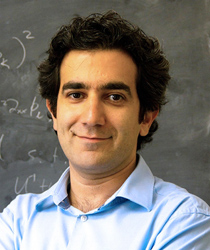
Hafezi, Mohammad
Minta Martin Professor
Electrical and Computer Engineering
Joint Quantum Institute
Quantum Technology Center
Joint Quantum Institute
Quantum Technology Center
2107 Atlantic Building
EDUCATION
- Ph.D., Physics, Harvard University, 2009
BACKGROUND
Professor Hafezi studied for two years at Sharif University before completing his undergraduate degree in Physics from École Polytechnique. He received his Ph.D. in Physics from Harvard University in 2009. He was a senior research associate at the Joint Quantum Institute before joining the ECE faculty.
HONORS AND AWARDS
- American Physical Society Fellow (2021)
- Simons Investigator Award - Physics (2020)
- Finalist of Prestigious Blavatnik National Awards for Young Scientists - Physical Sciences & Engineering Category (2020)
- Finalist of Prestigious Blavatnik National Awards for Young Scientists - Physical Sciences & Engineering Category (2019)
- George Corcoran Memorial Teaching Award for Faculty (2017)
- Young Investigator Program, Office of Naval Research (2015)
- Sloan Research Fellowship, Alfred P. Sloan Foundation (2015)
- Quantum simulation
- Quantum hybrid systems: optomechanics, circuit-QED
- Topological features in photonic systems
- Optical communication and computation
Led by Professor Mohammad Hafezi, Researchers Identify Groovy Way to Beat Diffraction Limit
Paper published in journal Science AdvancesCharting the Future of Quantum Engineering
The future of quantum science and technology is being defined by leading researchers around the world, including at the University of Maryland (UMD).New Photonic Chip Spawns Nested Topological Frequency Comb
Research by Professors Mohammad Hafezi and Yanne Chembo published in June 21, 2024 issue of ScienceMaryland Engineering Collaborates on Three MURIs
Multidisciplinary University Research Initiative (MURI) awards support growth of newly emerging technologies.Mohammad Hafezi Named 2021 APS Fellow
For pioneering theoretical and experimental work in topological photonics and quantum synthetic matter.Novel Design May Boost Efficiency of On-Chip Frequency Combs
A collaboration of researchers at UMD has proposed a way to make chip-sized frequency combs ten times more efficient by harnessing the power of topology.Kollár Receives NSF MRI Grant to Enhance Micro/Nanofabrication Initiatives
The MLA150 instrument supports various research projects in materials science, nanoscience, energy science, and quantum science.UMD joins NSF-funded revolutionary $25M center for optoelectronic, quantum technologies
The University of Maryland is one of 11 academic institutions that make up the Center for Integration of Modern Optoelectronic Materials on Demand (IMOD).UMD Leads New $25M NSF Quantum Leap Challenge Institute for Robust Quantum Simulation
New institute will significantly add to the vibrant quantum research ecosystem established in the mid-Atlantic region.Hafezi Appointed as Minta Martin Professor of Engineering
Hafezi is known for his contributions in a number of works to synthesize and characterize quantum many-body and topological physics beyond electronic systems.Hafezi's Group Generates Tunable Twin Particles of Light
The group developed a new method for generating entangled, indistinguishable photon pairs using a chip-based, topological approach.Maryland Graduate Engineering Ranked #10 Public in the Nation
From extreme batteries to windows made from wood, Clark School’s trendsetting work ranks it among the country’s Top 10 public engineering schools for the 3rd consecutive year.Three Clark School Professors Receive Competitive DURIP Grants
DURIP supports university research in technical areas of interest to the Department of Defense (DoD).New $115 Million Quantum Systems Accelerator to Pioneer Quantum Technologies for Discovery Science
Berkeley Lab-led Center to catalyze U.S. leadership in quantum information science, and strengthen the nation's research community to accelerate commercialization.Mohammad Hafezi Wins 2020 Simons Foundation Investigator Award
Simons Investigators are outstanding theoretical scientists who receive a stable base of research support from the foundation, enabling them to undertake the long-term study of fundamental questions.Hafezi, Hu Named Blavatnik Finalists for Second Straight Year
For the second year in a row, two Clark School faculty members have been named Finalists of the Blavatnik National Awards for Young Scientists.New Protocol Helps Classify Topological Matter
In a new paper in Science Advances, researchers from UMD and several other institutions presented a new method for identifying and characterizing topological invariants on various experimental platforms, testing their protocol in a quantum simulator made of neutral atoms.Charting a Course Toward Quantum Simulations of Nuclear Physics
Researchers explore how to map lattice gauge theories to ion traps.